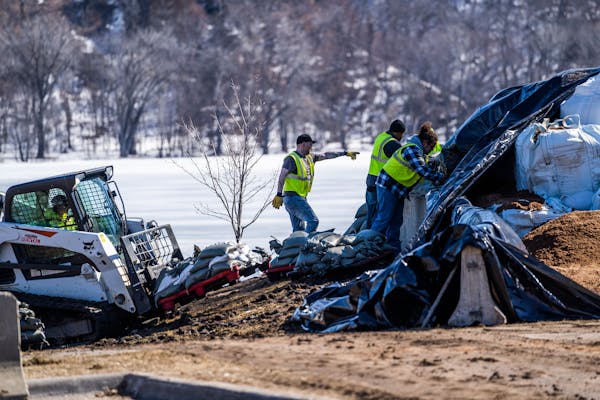DULUTH — The sheer amount of water soaked into snowpack across much of Minnesota led to an upgraded spring flood outlook this week after one of the state's snowiest winters.
The Mississippi and St. Croix rivers from the metro area and continuing south pose the biggest threats of major flooding the longer snow hangs around and weather stays cold, the National Weather Service said, with their tributaries expected to be running high.
"The snowpack is so widespread this year, just about everywhere except right along the southern tier of counties in Minnesota can be under the gun," said Craig Schmidt, a hydrologist with the weather service in the Twin Cities.
The amount of water contained in snow accumulated on the ground is the fuel that drives the spring snowmelt, with 3-6 inches of water sitting in 12-20 inches of snowpack across much of the state, and even higher in the Arrowhead region.
The state has recovered from recent drought enough that there's not as much room in soil to absorb so much water. Minimal frost underground, which can help prevent rapid run-off, should help, along with low-water wetlands and some river levels that were near normal when water first froze.
But if warm spring weather comes quickly, "that could drive a very big flood," Schmidt said.
The amount of water found in snowpack throughout the state is historically high, seen just a handful of times in the past 70 years, the Weather Service said.
But there is good news for the flood-weary Rainy River Basin: The northern Minnesota region experienced historic, devastating floods last spring and summer, triggering a National Guard response. Homes and businesses tried to stave off encroaching water for weeks, and many properties were badly damaged by water.
Snowpack there is about average, and similar flooding isn't likely as long as the area doesn't have an especially rainy April, said Joe Moore, a meteorologist with the National Weather Service's Duluth office.
In northeastern Minnesota, where Duluth is headed for a record-breaking seasonal snowfall, rivers will again run high. Last spring along the North Shore, rivers swollen from rain and rapid snowmelt destroyed historic bridges, closed state parks and nearly spilled onto Hwy. 61 at the Cascade River bridge.
Duluth has about 9 inches of water in its snowpack, which stood at 34 inches in all mid-week and with a storm dropping more snow Thursday and today.
So, what does all this mean? Perhaps look into flood insurance, Moore said.
With most policies needing 30 days to take effect, "now is the time to make plans," he said.

University of Minnesota police arrest 9 after pro-Palestinian encampment set up on campus
2 dead in Lino Lakes, no known threat to public, police say
Teen charged with murder in deadly St. Paul shooting last month

